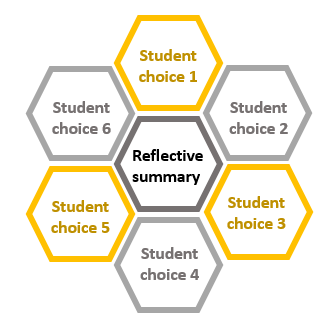Patchwork Assessment
Patchwork assessment is based on a student-driven, flexible way of demonstrating acquired competences.
Patchwork feedback applies formative and summative assessment and permits continuous, deep learning and student-driven pacing. It is based on the patchwork text (PT) assessment innovation (Dalrymple & Smith 2008), and offers an approach for an inclusive assessment strategy (Gandhi). The use of different formats empowers different student “voices”.
Key aspects of Patchwork Assessment
-
Variety of small sections (patches).
-
Focus on different aspects of the course.
-
Students can choose how they present their patches (e.g. essay, poster, book review, podcast, video clip).
-
Students are enabled to work in their preferred learning styles.
-
No distinction between types of students as different learners seen as a part of a continuum of learners with different strengths and weaknesses.
-
Flexibility of assessment choice.
-
Student preference for assessment modes.
-
Core and optional elements.
-
Resubmission of prior patches.
-
Provision of summative feedback before the final submission.
-
Patches stitched together with a retrospective reflection and analysis.
.

Sources:
Gandhi, S. (2016) Confessions of an accidental inclusivist. In: Equality and diversity in learning and teaching in higher education. Papers from Equality Challenge Unit and Higher Education Academy joint conferences.
Dalrymple, R and Smith, P (2008) The patchwork text: enabling discursive writing and reflective practice on a foundation module in work-based learning. Innovations in Education and Teaching International 45(1), 47–54.
